Reliability of the ERA5 in Replicating Mean and Extreme Temperatures across Europe
Abstract
:1. Introduction
2. Materials and Methods
3. Results
3.1. Spatial Resolution of Mean Temperature
3.2. Spatial Resolution of Extreme Temperature
3.3. Statistical Analysis of Extreme Temperature
4. Discussion
5. Conclusions
- In general, ERA5 captures the spatial distribution of mean temperature over Europe, however in latitudes higher than 55° N, ERA5 presents some weaknesses in simulating the temperature values (especially over the Scandinavian region).
- Moreover, the complex topography of certain areas affects the performance of ERA5 (e.g., the Alps and Mediterranean). The results must be interpreted with caution in areas with complex terrain, since the alternation between land and sea plays an important role in the observed differences between ERA5 and E-OBS. In case there is a need to correct these temperature datasets, and especially extreme temperatures, statistics of extremes should be utilized [34,35,36].
- Analogous to the annual ones were the results when the analysis was conducted on a seasonal scale.
- The comparison with the station network revealed that in southern Europe, the examined parameter is in many cases underestimated.
- Regarding extreme low temperatures, the weakest performance of ERA5 was noted over the northern and southern regions of Europe.
- The results of the 95th percentile are different, and ERA5 generally overestimates the high mean temperatures (not statistically significant differences).
- The examination of the temperature statistics among the compared datasets showed that ERA5 presents more extreme values (southern to 40° latitude) and less extreme temperatures in areas over the Black Sea.
- In Scandinavia, ERA5 temperatures are often more extreme than the observational ones.
Author Contributions
Funding
Institutional Review Board Statement
Informed Consent Statement
Data Availability Statement
Acknowledgments
Conflicts of Interest
References
- Acharya, S.C.; Nathan, R.; Wang, Q.J.; Su, C.-H.; Eizenberg, N. An evaluation of daily precipitation from a regional atmospheric reanalysis over Australia. Hydrol. Earth Syst. Sci. 2019, 23, 3387–3403. [Google Scholar] [CrossRef] [Green Version]
- Jiang, Q.; Li, W.; Fan, Z.; He, X.; Sun, W.; Chen, S.; Wen, J.; Gao, J.; Wang, J. Evaluation of the ERA5 reanalysis precipitation dataset over Chinese Mainland. J. Hydrol. 2021, 595, 125660:1–125660:15. [Google Scholar] [CrossRef]
- Tarek, M.; Brissette, F.P.; Arsenault, R. Evaluation of the ERA5 reanalysis as a potential reference dataset for hydrological modelling over North America. Hydrol. Earth Syst. Sci. 2020, 24, 2527–2544. [Google Scholar] [CrossRef]
- Isotta, F.A.; Vogel, R.; Frei, C. Evaluation of European regional reanalyses and downscalings for precipitation in the Alpine region. Meteorol. Z. 2015, 24, 15–37. [Google Scholar] [CrossRef]
- Yang, K.; Zhang, J. Evaluation of reanalysis datasets against observational soil temperature data over China. Clim. Dyn. 2018, 50, 317–337. [Google Scholar] [CrossRef]
- Rapaić, M.; Brown, R.; Markovic, M.; Chaumont, D. An evaluation of temperature and precipitation surface-based and reanalysis datasets for the Canadian Arctic, 1950–2010. Atmos.-Ocean 2015, 53, 283–303. [Google Scholar] [CrossRef]
- Shah, R.; Mishra, V. Evaluation of the reanalysis products for the monsoon season droughts in India. J. Hydrometeorol. 2014, 15, 1575–1591. [Google Scholar] [CrossRef]
- Hagemann, S.; Arpe, K.; Bengtsson, L. Validation of the Hydrological Cycle of ERA40. Reports on Earth System Science; Max Planck Institute for Meteorology: Hamburg, Germany, 2005; ISBN 1614-1199. [Google Scholar]
- Bosilovich, M.G.; Robertson, F.R.; Chen, J. Global energy and water budgets in MERRA. J. Clim. 2011, 24, 5721–5739. [Google Scholar] [CrossRef]
- Zhang, L.; Kumar, A.; Wang, W. Influence of changes in observations on precipitation: A case study for the Climate Forecast System Reanalysis (CFSR). J. Geophys. Res. 2012, 117, D08105:1–D08105:14. [Google Scholar] [CrossRef] [Green Version]
- Hersbach, H.; Dee, D. ERA5 reanalysis is in production. In ECMWF Newsletter No. 147; Lentze, G., Ed.; European Centre for Medium-Range Weather Forecasts (ECMWF): Reading, UK, 2016; p. 7. [Google Scholar]
- Xu, X.; Frey, S.K.; Boluwade, A.; Erler, A.R.; Khader, O.; Lapen, D.R.; Sudicky, E. Evaluation of variability among different precipitation products in Northern Great Plains. J. Hydrol. Reg. Stud. 2019, 24, 100608:1–100608:18. [Google Scholar] [CrossRef]
- Amjad, M.; Yilmaz, M.T.; Yucel, I.; Yilmaz, K.K. Performance evaluation of satellite- and model- based precipitation products over varying climate and complex topography. J. Hydrol. 2020, 584, 124707:1–124707:17. [Google Scholar] [CrossRef]
- Nogueira, M. Inter-comparison of ERA-5, ERA-interim and GPCP rainfall over the last 40 years: Process-based analysis of systematic and random differences. J. Hydrol. 2020, 583, 124632:1–124632:17. [Google Scholar] [CrossRef]
- Urraca, R.; Huld, T.; Gracia-Amillo, A.; Martinez-de-Pison, F.J.; Kaspar, F.; Sanz-Garcia, A. Evaluation of global horizontal irradiance estimates from ERA5 and COSMO-REA6 reanalyses using ground and satellite-based data. Sol. Energy 2018, 164, 339–354. [Google Scholar] [CrossRef]
- Johannsen, F.; Ermida, S.; Martins, J.P.A.; Trigo, I.F.; Nogueira, M.; Dutra, E. Cold bias of ERA5 summertime daily maximum land surface temperature over Iberian Peninsula. Remote Sens. 2019, 11, 2570. [Google Scholar] [CrossRef] [Green Version]
- Jourdier, B. Evaluation of ERA5, MERRA-2, COSMO-REA6, NEWA and AROME to simulate wind power production over France. Adv. Sci. Res. 2020, 17, 63–77. [Google Scholar] [CrossRef]
- Luo, B.; Minnett, P.J. Evaluation of the ERA5 sea surface skin temperature with remotely-sensed shipborne marine-atmospheric emitted radiance interferometer data. Remote Sens. 2020, 12, 1873. [Google Scholar] [CrossRef]
- Urban, A.; Di Napoli, C.; Cloke, H.L.; Kyselý, J.; Pappenberger, F.; Sera, F.; Schneider, R.; Vicedo-Cabrera, A.M.; Acquaotta, F.; Ragettli, M.S.; et al. Evaluation of the ERA5 reanalysis-based Universal Thermal Climate Index on mortality data in Europe. Environ. Res. 2021, 198, 111227:1–111227:12. [Google Scholar] [CrossRef]
- Hersbach, H.; Bell, B.; Berrisford, P.; Horányi, A.; Sabater, J.M.; Nicolas, J.; Radu, R.; Schepers, D.; Simmons, A.; Soci, C.; et al. Global reanalysis: Goodbye ERA-Interim, hello ERA5. In ECMWF Newsletter No. 159; Lentze, G., Ed.; European Centre for Medium-Range Weather Forecasts (ECMWF): Reading, UK, 2019; pp. 17–24. [Google Scholar] [CrossRef]
- Gleixner, S.; Demissie, T.; Diro, G.T. Did ERA5 improve temperature and precipitaqtion reanalysis over East Africa? Atmosphere 2020, 11, 996. [Google Scholar] [CrossRef]
- Klein Tank, A.M.G.; Wijngaard, J.B.; Können, G.P.; Böhm, R.; Demarée, G.; Gocheva, A.; Mileta, M.; Pashiardis, S.; Hejkrlik, L.; Kern-Hansen, C.; et al. Daily dataset of 20th-century surface air temperature and precipitation series for the European Climate Assessment. Int. J. Climatol. 2002, 22, 1441–1453. [Google Scholar] [CrossRef]
- Haylock, M.R.; Hofstra, N.; Klein Tank, A.M.G.; Klok, E.J.; Jones, P.D.; New, M. A European daily high-resolution gridded data set of surface temperature and precipitation for 1950–2006. J. Geophys. Res. Atmos. 2008, 113, D20119:1–D20119:12. [Google Scholar] [CrossRef] [Green Version]
- Kotlarski, S.; Keuler, K.; Christensen, O.B.; Colette, A.; Déqué, M.; Gobiet, A.; Goergen, K.; Jacob, D.; Lüthi, D.; van Meijgaard, E.; et al. Regional climate modeling on European scales: A joint standard evaluation of the EURO-CORDEX RCM ensemble. Geosci. Model Dev. 2014, 7, 1297–1333. [Google Scholar] [CrossRef] [Green Version]
- Karl, T.R.; Meehl, G.A.; Miller, C.D.; Hassol, S.J.; Waple, A.M.; Murray, W.L. Weather and Climate Extremes in a Changing Climate. Regions of Focus: North America, Hawaii, Caribbean and U.S. Pacific Islands. A Report by the U.S. Climate Change Science Program and the Subcommittee on Global Change Research; Department of Commerce, NOAA’s National Climatic Data Center: Washington, DC, USA, 2008.
- Coelho, C.A.S.; Ferro, C.A.T.; Stephenson, D.B.; Steinskog, D.J. Methods for exploring spatial and temporal variability of extreme events in climate data. J. Clim. 2008, 21, 2072–2092. [Google Scholar] [CrossRef] [Green Version]
- Heikkilä, U.; Sandvik, A.; Sorteberg, A. Dynamical downscaling of ERA-40 in complex terrain using the WRF regional climate model. Clim. Dyn. 2011, 37, 1551–1564. [Google Scholar] [CrossRef] [Green Version]
- Bandhauer, M.; Isotta, F.; Lakatos, M.; Lussana, C.; Båserud, L.; Izsák, B.; Szentes, O.; Tveito, O.E.; Frei, C. Evaluation of daily precipitation analyses in E-OBS (v19.0e) and ERA5 by comparison to regional high-resolution datasets in European regions. Int. J. Climatol. 2022, 42, 727–747. [Google Scholar] [CrossRef]
- Mahto, S.S.; Mishra, V. Does ERA-5 outperform other reanalysis products for hydrologic applications in India? J. Geophys. Res. Atmos. 2019, 124, 9423–9441. [Google Scholar] [CrossRef]
- Betts, A.K.; Chan, D.Z.; Desjardins, R.L. Near-surface biases in ERA5 over the Canadian Prairies. Front. Environ. Sci. 2019, 7, 129:1–129:17. [Google Scholar] [CrossRef]
- Wang, C.; Graham, R.M.; Wang, K.; Gerland, S.; Granskog, M.A. Comparison of ERA5 and ERA-Interim near-surface air temperature, snowfall and precipitation over Arctic sea ice: Effects on sea ice thermodynamics and evolution. Cryosphere 2019, 13, 1661–1679. [Google Scholar] [CrossRef] [Green Version]
- Keller, J.D.; Wahl, S. Representation od climate in reanalyses: An intercomparison for Europe and North America. J. Clim. 2021, 34, 1667–1684. [Google Scholar] [CrossRef]
- Rakhmatova, N.; Arushanov, M.; Shardakova, L.; Nishonov, B.; Taryannikova, R.; Rakhmatova, V.; Belikov, D.A. Evaluation of the perspective of ERA-Interim and ERA5 reanalyses for calculation of drought indicators for Uzbekistan. Atmosphere 2021, 12, 527. [Google Scholar] [CrossRef]
- Lazoglou, G.; Anagnostopoulou, C.; Tolika, K.; Kolyva-Machera, F. A review of statistical methods to analyze extreme precipitation and temperature events in the Mediterranean region. Theor. Appl. Climatol. 2019, 136, 99–117. [Google Scholar] [CrossRef]
- Lazoglou, G.; Gräler, B.; Anagnostopoulou, C. Simulation of extreme temperatures using a new method: TIN-copula. Int. J. Climatol. 2019, 39, 5201–5214. [Google Scholar] [CrossRef]
- Lazoglou, G.; Anagnostopoulou, C.; Tolika, K.; Gräler, B. Evaluation of a new statistical method–TIN-Copula–for the bias correction of climate models’ extreme parameters. Atmosphere 2020, 11, 243. [Google Scholar] [CrossRef] [Green Version]
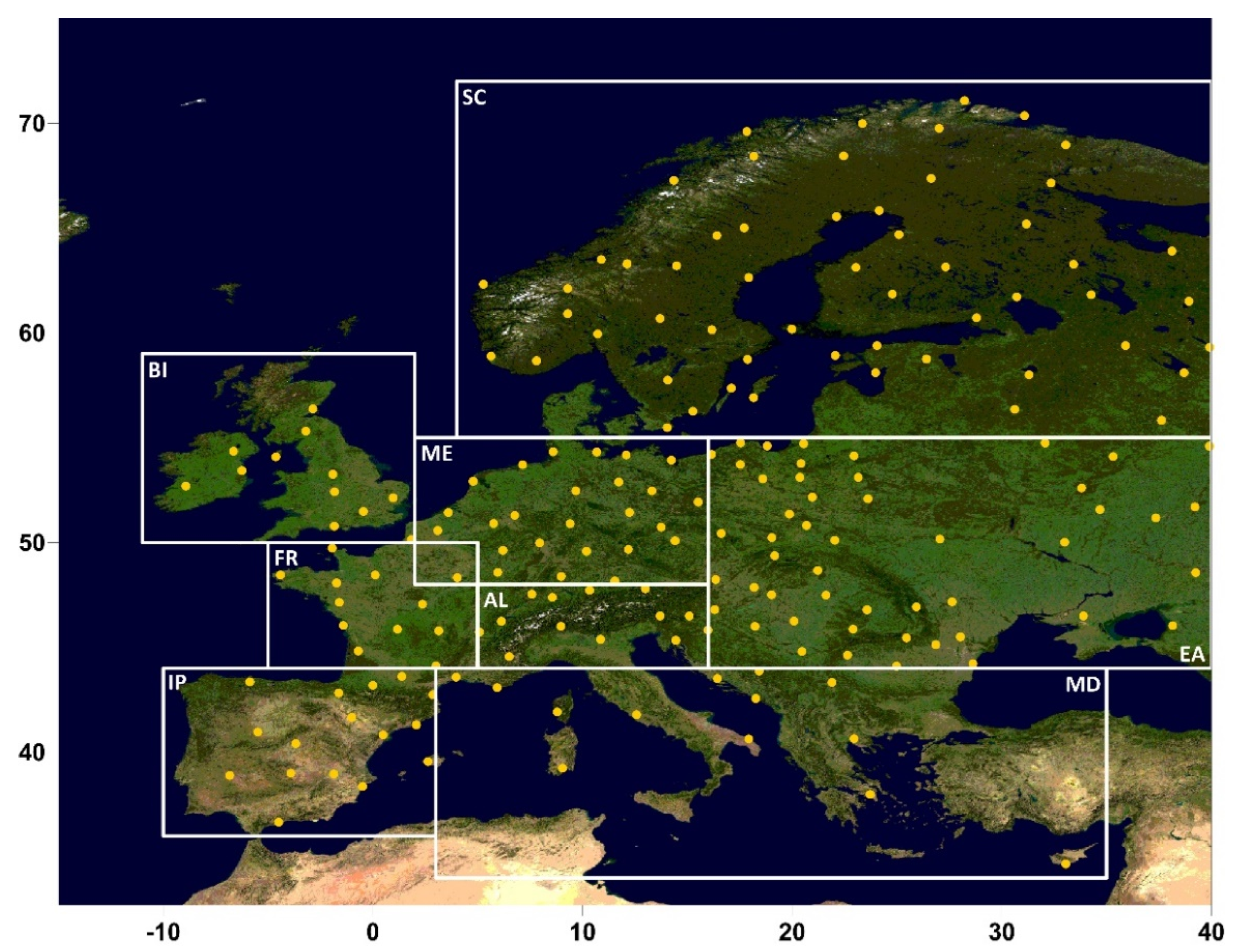
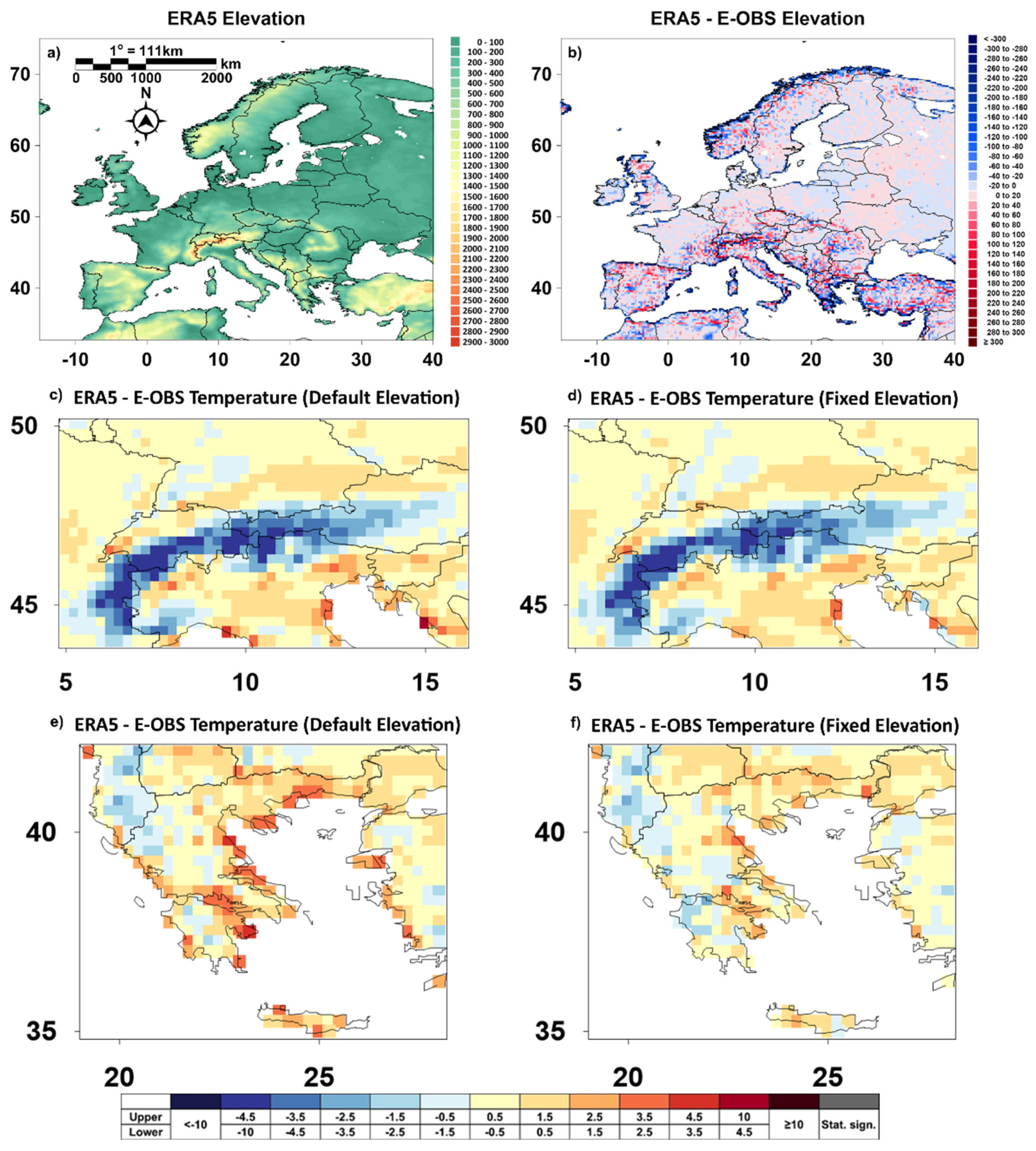
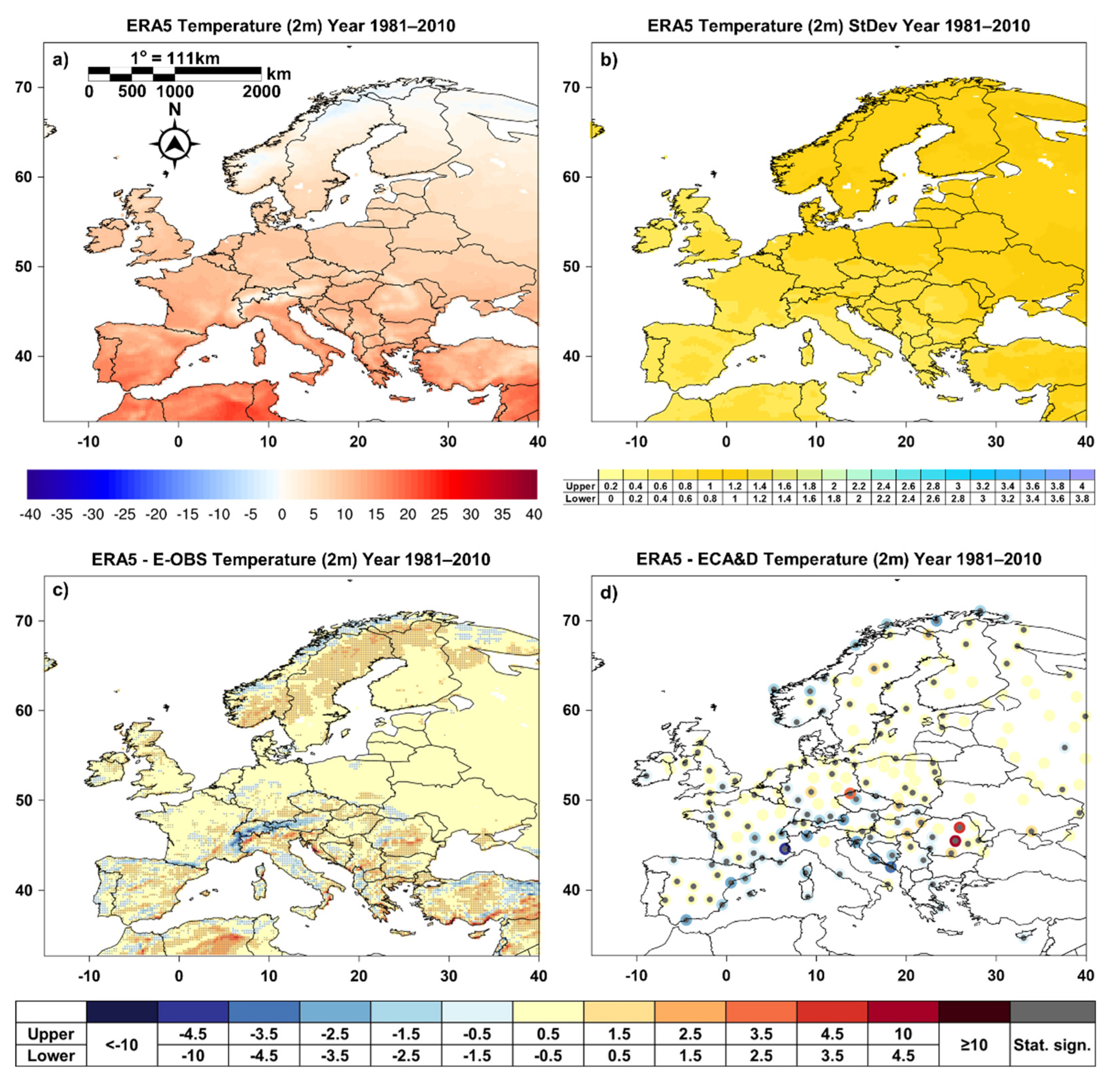
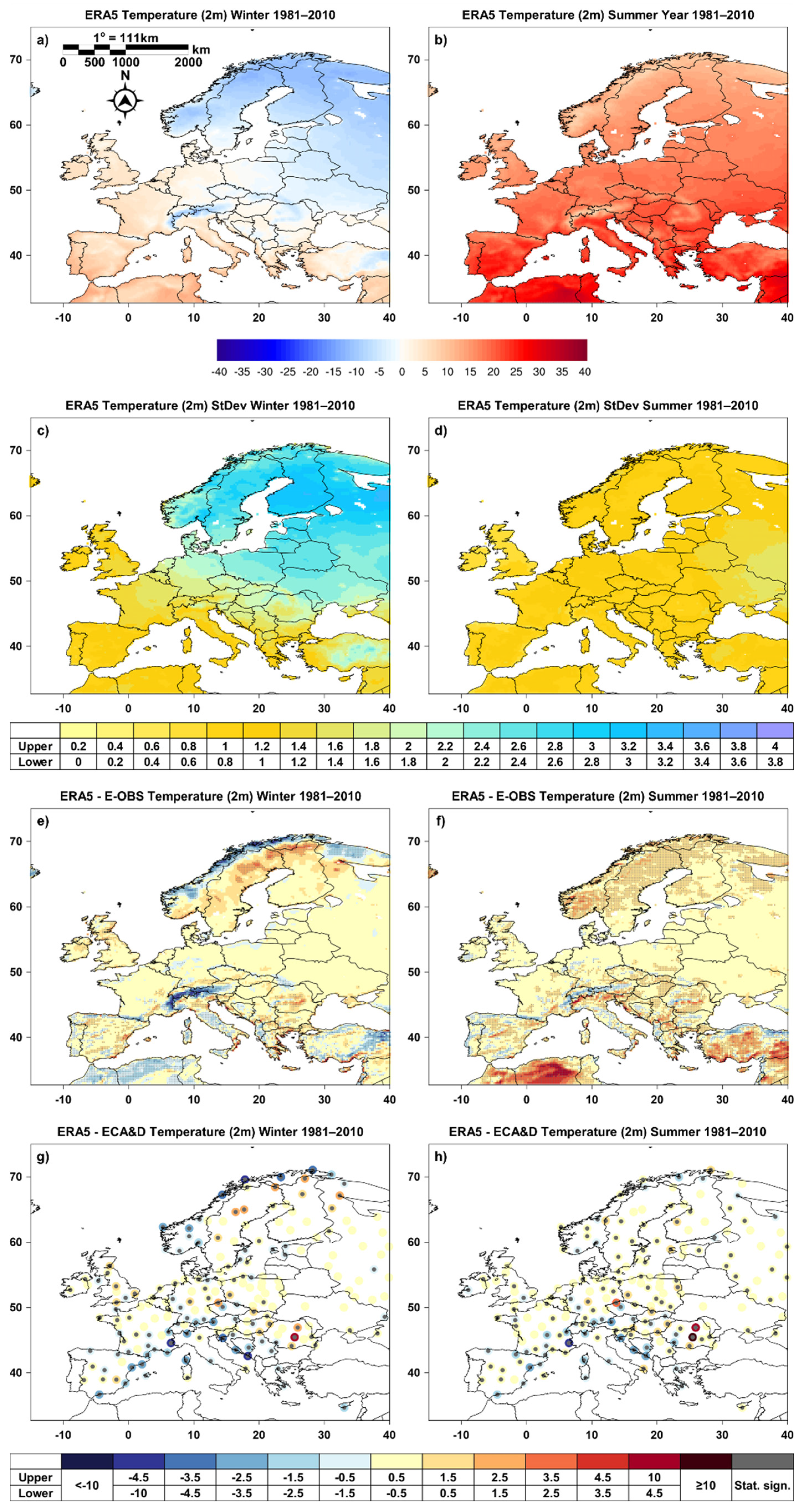
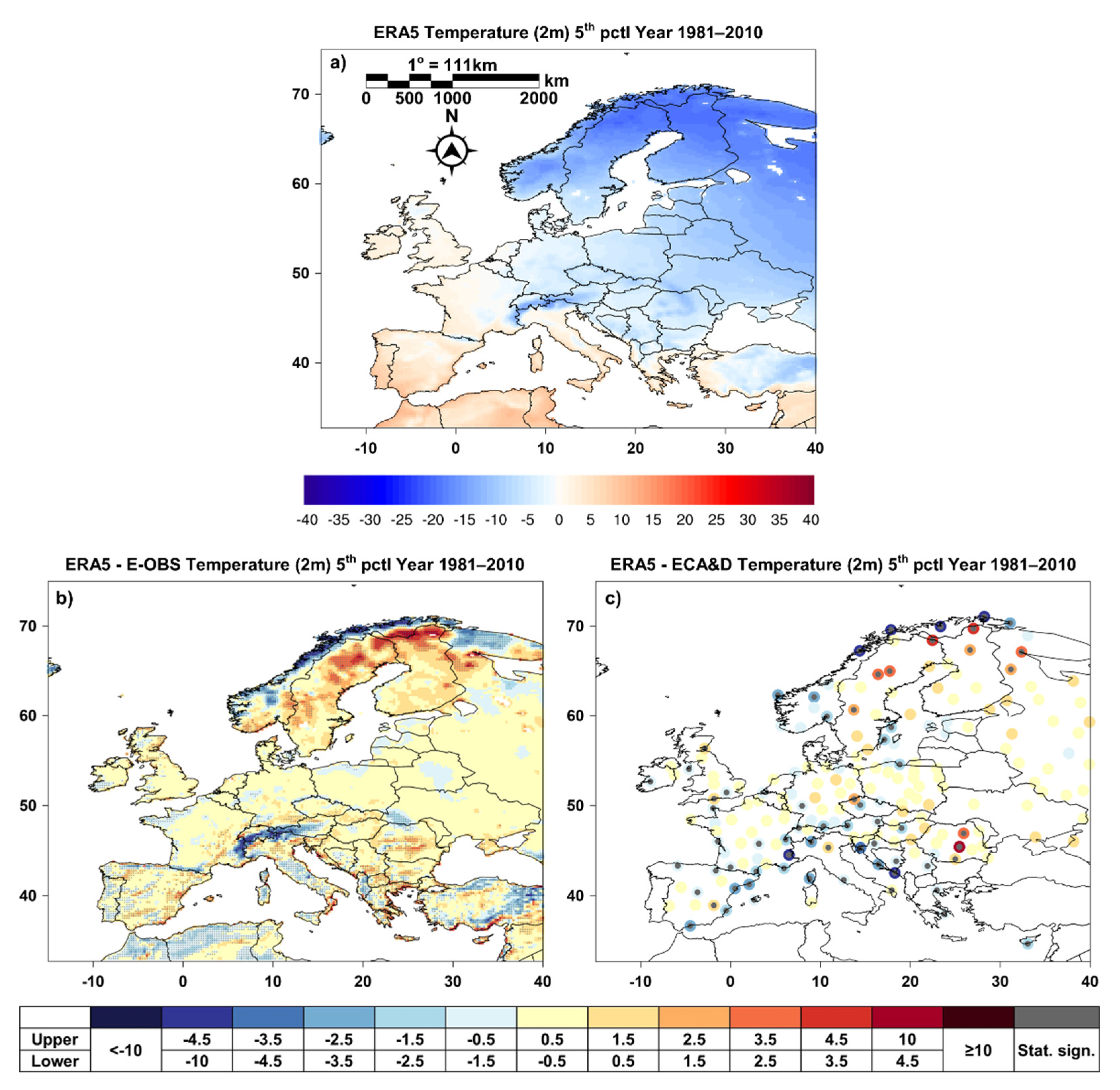
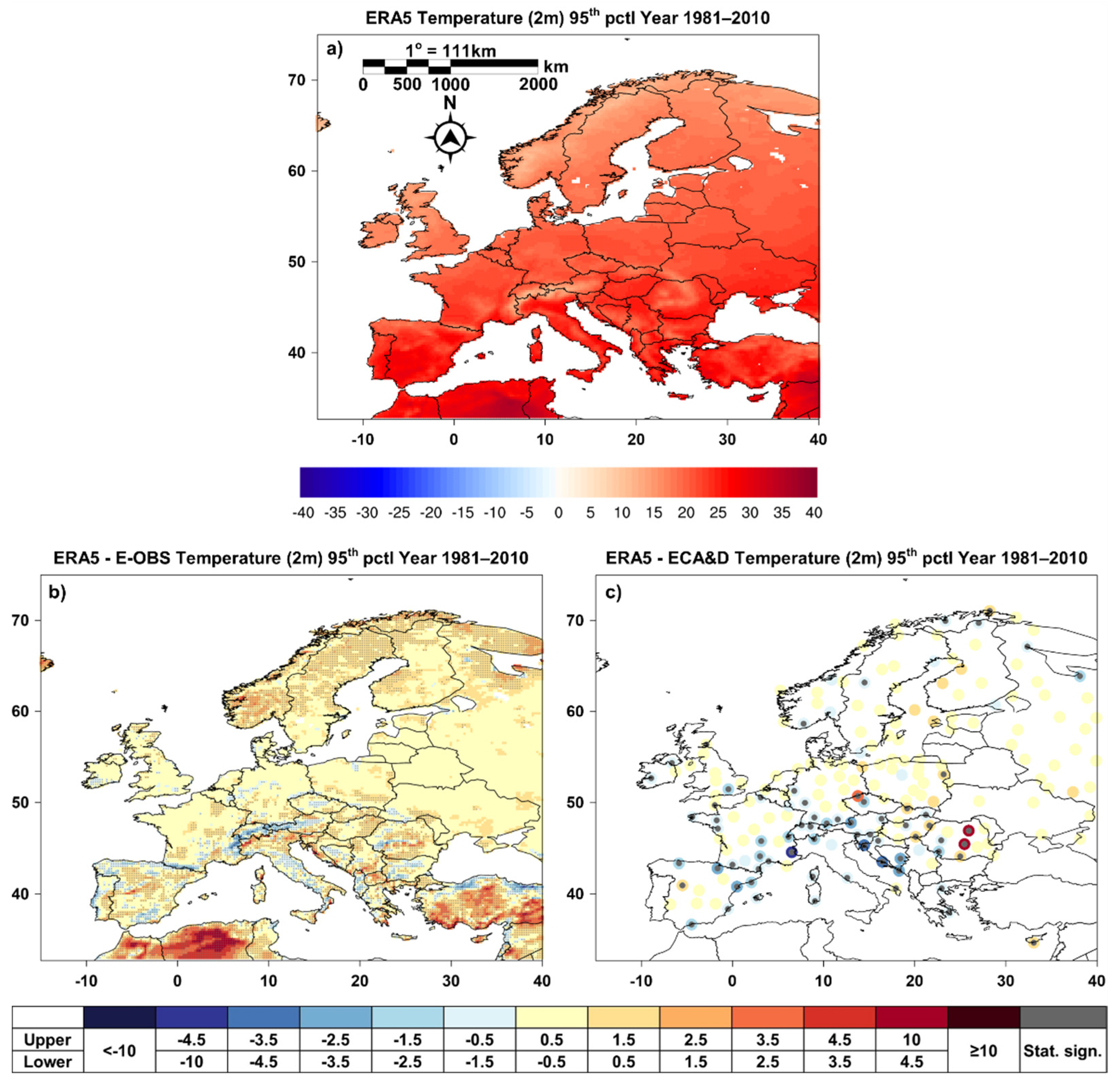

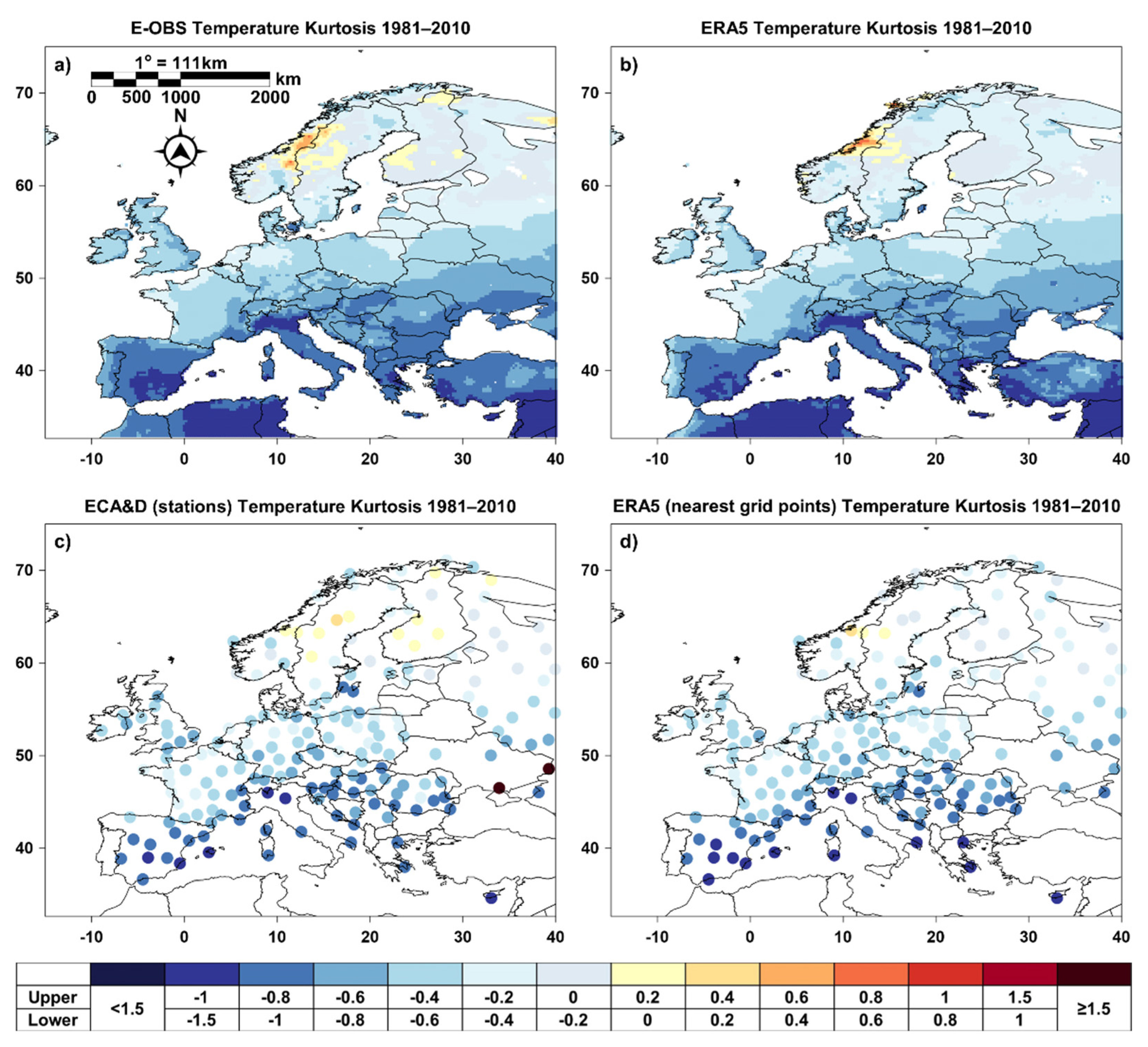
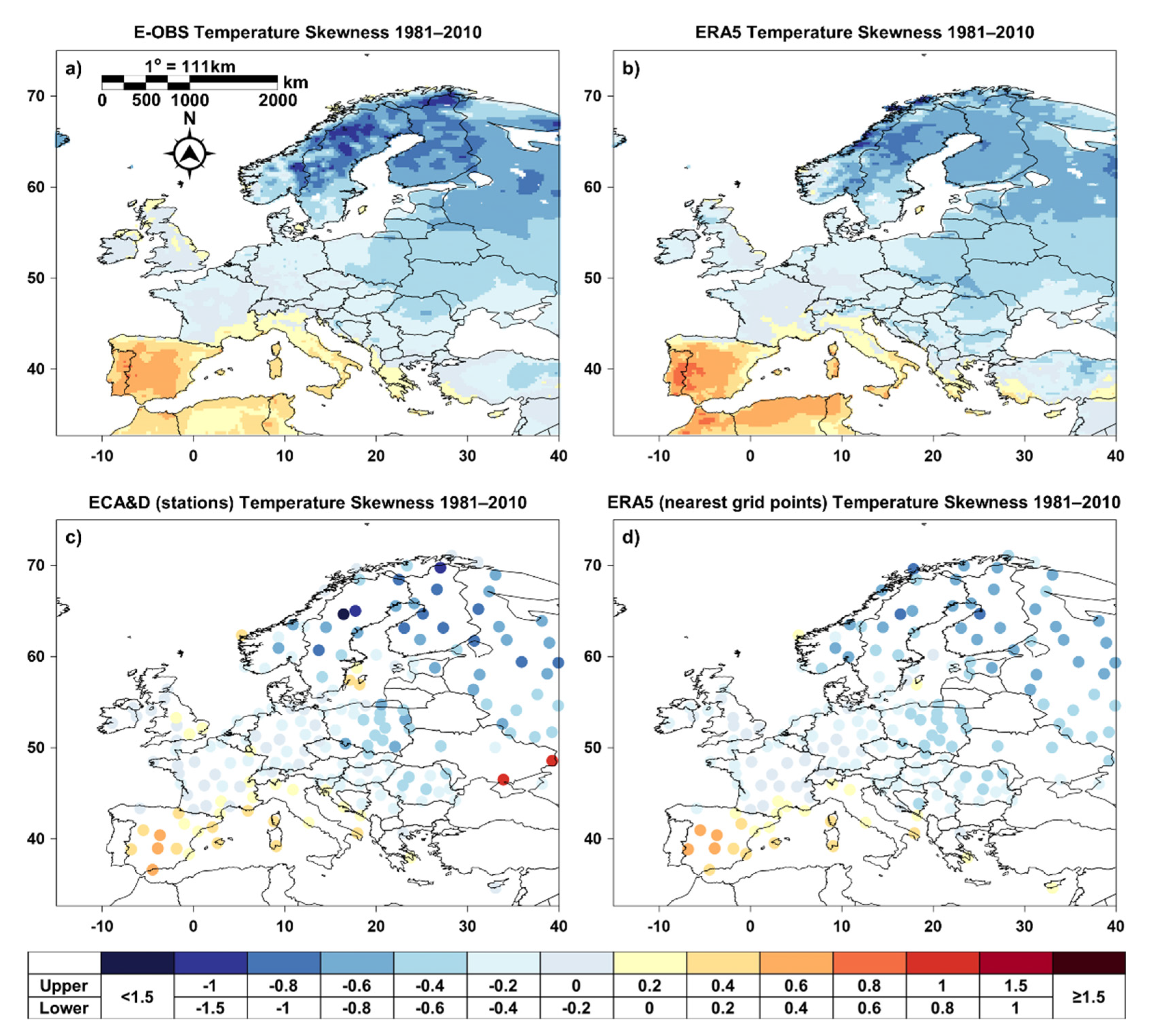
| ERA5–E-OBS | ||||
| Subregion | Correlation | RMSE | Mean Bias | StDB |
| AL | 0.997 | 0.66 | −0.19 | 0.63 |
| BI | 0.995 | 0.52 | 0.23 | 0.47 |
| EA | 1.000 | 0.22 | 0.11 | 0.20 |
| FR | 0.998 | 0.38 | −0.01 | 0.38 |
| IP | 0.998 | 0.37 | 0.04 | 0.37 |
| MD | 0.997 | 0.75 | 0.36 | 0.66 |
| ME | 0.999 | 0.37 | 0.02 | 0.37 |
| SC | 1.000 | 0.38 | 0.25 | 0.30 |
| ERA5–ECA&D | ||||
| Subregion | Correlation | RMSE | Mean Bias | StDB |
| AL | 0.999 | 1.84 | −1.80 | 0.40 |
| BI | 0.995 | 0.51 | −0.06 | 0.51 |
| EA | 1.000 | 0.34 | 0.26 | 0.22 |
| FR | 0.998 | 0.61 | −0.45 | 0.41 |
| IP | 0.999 | 1.10 | −1.04 | 0.36 |
| MD | 0.998 | 1.39 | −1.32 | 0.43 |
| ME | 0.998 | 0.40 | −0.06 | 0.40 |
| SC | 1.000 | 0.37 | −0.25 | 0.27 |
Publisher’s Note: MDPI stays neutral with regard to jurisdictional claims in published maps and institutional affiliations. |
© 2022 by the authors. Licensee MDPI, Basel, Switzerland. This article is an open access article distributed under the terms and conditions of the Creative Commons Attribution (CC BY) license (https://creativecommons.org/licenses/by/4.0/).
Share and Cite
Velikou, K.; Lazoglou, G.; Tolika, K.; Anagnostopoulou, C. Reliability of the ERA5 in Replicating Mean and Extreme Temperatures across Europe. Water 2022, 14, 543. https://doi.org/10.3390/w14040543
Velikou K, Lazoglou G, Tolika K, Anagnostopoulou C. Reliability of the ERA5 in Replicating Mean and Extreme Temperatures across Europe. Water. 2022; 14(4):543. https://doi.org/10.3390/w14040543
Chicago/Turabian StyleVelikou, Kondylia, Georgia Lazoglou, Konstantia Tolika, and Christina Anagnostopoulou. 2022. "Reliability of the ERA5 in Replicating Mean and Extreme Temperatures across Europe" Water 14, no. 4: 543. https://doi.org/10.3390/w14040543
APA StyleVelikou, K., Lazoglou, G., Tolika, K., & Anagnostopoulou, C. (2022). Reliability of the ERA5 in Replicating Mean and Extreme Temperatures across Europe. Water, 14(4), 543. https://doi.org/10.3390/w14040543








